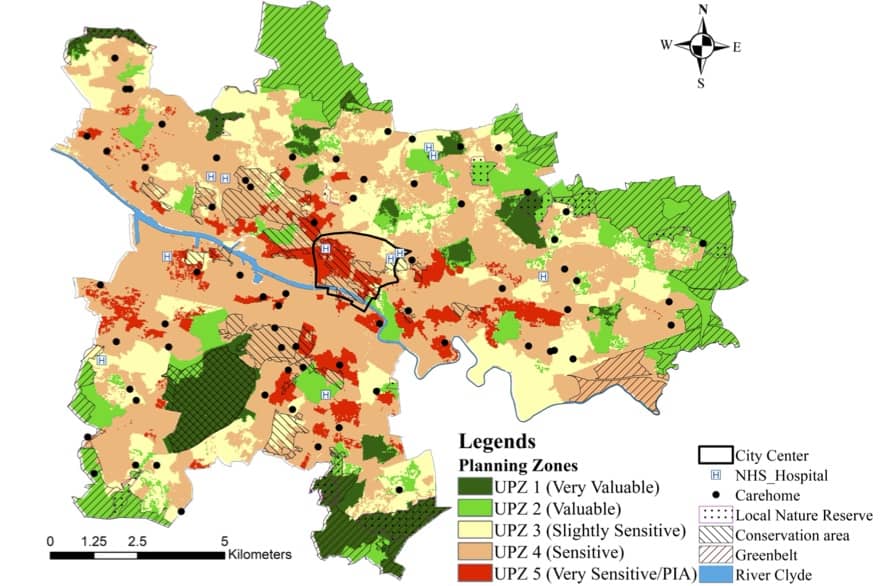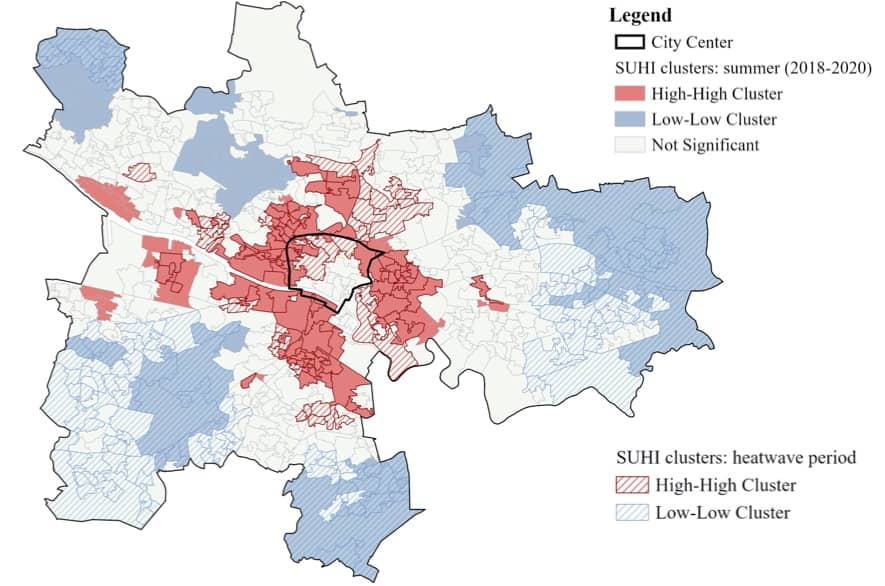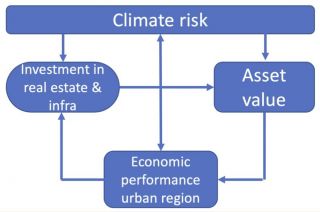
www.buildingsandcities.org/insights/commentaries/cities-planning-heat.html
Climate Adaptation in Cities: Planning for Heat Vulnerability
By Rohinton Emmanuel (Glasgow Caledonian University, UK)
Urban warming creates a 'double jeopardy' on a majority of humans (urban heat island and global warming). Sufficient information exists to identify where local action is most needed to protect those who are most vulnerable. As a matter of urgency, COP-26, national governments and local authorities need to address heat vulnerability by identifying vulnerable areas and implementing changes in planning practices.
Along with providing more irrefutable proof of the anthropogenic causes of global warming, the recently released 6th Assessment Report (AR6) of the Intergovernmental Panel on Climate Change (IPCC, 2021) also highlighted the nexus between urbanisation and microclimate and their superimposing effects with global and regional warming. AR6 concluded that 'there is very high confidence that future urbanization will amplify the projected air temperature warming (in cities) irrespective of the background climate' and the effect on nocturnal warming 'could be locally comparable in magnitude to the global GHG-induced warming' (IPCC, 2021: 10-115). Urban growth further exacerbates the possibilities for increases in the frequency and magnitude of extreme events such as heatwaves.

Note: 'UPZ' refers to Urban Planning Zones based on urban climate actions recommended (UPZ1 is highly valuable in terms of ecosystem services provided by existing landscape and therefore no change is needed/allowed; UPZ 5 - areas of high sensitivity to heat vulnerability and where climate action is most needed. Source: Begum (2021).
What can municipalities and urban planners do to address this challenge? A key consideration for adapting to climate change is the impact at the microscale: the microclimate which is influenced by local surroundings and climate context.
Planning action has a vital role to anticipate and adapt to climate change especially the microclimate element as this impacts on individual dwellings, buildings and outside spaces. We must now actively engage with this because urban built form evolves slowly over time. We must ensure that climate change does not exacerbate existing inequalities but act in a manner that equitably distribute the climate change burden.
The good news is that the same variables that lead to local warming (i.e. the way land is used and covered, the configuration (massing) of buildings relative to each other and in relation to streets, the thermal properties of building materials and pollution from human activities, see Emmanuel, 2021) could also be used to map heat vulnerability. Even in the absence of detailed local climate information, such mapping could highlight local areas of relative heat vulnerability at a fine enough scale for planning action to mitigate the negative consequences of local climate change.
Figure 1 shows such an approach to local scale heat vulnerability mapping in Glasgow, the host city of COP-26. No additional data was needed to create such a heat vulnerability map: existing census data on population, climate and land use were used. Super-imposing this on socio-economic conditions in the city ('deprivation' data) gives a first order indication of where vulnerability is at its highest and where adaptation action is most needed.

Note: 'High-high' cluster refers to areas where the land surface temperatures are high and spatial auto-correlation is also high; 'Low-Low' refers to areas where both these are low (i.e. 'cool' spots). Source: Ananyeya (2021).
Thus, we have the data and tools to map where the vulnerabilities are at their greatest (as shown in Figure 1) as well as where these are mostly clustered (Figure 2). Utilising this knowledge would help prioritise interventions and also identify where 'more bang for the buck' are likely. The inclusion of socio-economic conditions will foster equitable transition to a climate resilient future.
What is now needed are planning processes finely attuned to local realities to achieve the desired change. These could take the form of wind corridors for natural ventilation, judicious use of waterbodies and green infrastructure to reduce humidity levels, shading arrangements using built massing as well as green infrastructure, provision of shaded and well ventilated open space, as well as building level strategies where relatively modest alterations could lead to significant reduction in heat risk.
While we await intra-national, cross-border structural changes to limit GHG emissions as ultimate mitigation measures arising from COP26, equal emphasis is needed on these relatively low-cost, local adaptation actions that bring about immediate relief to urban dwellers. Given the uncertainties of local climate information, reversibility of local adaptation actions will greatly enhance resilience and nature-based solutions are particularly suited in this regard
References
Ananyeva, O. (2021). Green infrastructure cooling strategies for urban heat island mitigation in cities: case study of Glasgow City Centre, in R. Emmanuel et al. MUrCS Proceedings 2021, LAB University Press, Finland (in press)
Begum, R. (2021). A critical evaluation of different methods of urban climate mapping: a case study of Glasgow, in R. Emmanuel et al. MUrCS Proceedings 2021, LAB University Press, Finland (in press)
Emmanuel, R. (2021). Urban microclimate in temperate climates: a summary for practitioners. Buildings and Cities, 2(1), 402-410. https://doi.org/10.5334/bc.109
IPCC (2021). Climate Change 2021: The Physical Science Basis. Contribution of Working Group I to the Sixth Assessment Report of the Intergovernmental Panel on Climate Change [Masson-Delmotte, V., P. Zhai, A. Pirani, S. L. Connors, C. Péan, S. Berger, N. Caud, Y. Chen, L. Goldfarb, M. I. Gomis, M. Huang, K. Leitzell, E. Lonnoy, J.B.R. Matthews, T. K. Maycock, T. Waterfield, O. Yelekçi, R. Yu and B. Zhou (eds.)]. Cambridge University Press. https://www.ipcc.ch/report/ar6/wg1/#FullReport
Latest Peer-Reviewed Journal Content
A framework for 1.5°C-aligned GHG budgets in architecture
G Betti, I Spaar, D Bachmann, A Jerosch-Herold, E Kühner, R Yang, K Avhad & S Sinning
Net zero retrofit of the building stock [editorial]
D Godoy-Shimizu & P Steadman
Co-learning in living labs: nurturing civic agency and resilience
A Belfield
The importance of multi-roles and code-switching in living labs
H Noller & A Tarik
Researchers’ shifting roles in living labs for knowledge co-production
C-C Dobre & G Faldi
Increasing civic resilience in urban living labs: city authorities’ roles
E Alatalo, M Laine & M Kyrönviita
Co-curation as civic practice in community engagement
Z Li, M Sunikka-Blank, R Purohit & F Samuel
Preserving buildings: emission reductions from circular economy strategies in Austria
N Alaux, V Kulmer, J Vogel & A Passer
Urban living labs: relationality between institutions and local circularity
P Palo, M Adelfio, J Lundin & E Brandão
Living labs: epistemic modelling, temporariness and land value
J Clossick, T Khonsari & U Steven
Co-creating interventions to prevent mosquito-borne disease transmission in hospitals
O Sloan Wood, E Lupenza, D M Agnello, J B Knudsen, M Msellem, K L Schiøler & F Saleh
Circularity at the neighbourhood scale: co-creative living lab lessons
J Honsa, A Versele, T Van de Kerckhove & C Piccardo
Positive energy districts and energy communities: how living labs create value
E Malakhatka, O Shafqat, A Sandoff & L Thuvander
Built environment governance and professionalism: the end of laissez-faire (again)
S Foxell
Co-creating justice in housing energy transitions through energy living labs
D Ricci, C Leiwakabessy, S van Wieringen, P de Koning & T Konstantinou
HVAC characterisation of existing Canadian buildings for decarbonisation retrofit identification
J Adebisi & J J McArthur
Simulation and the building performance gap [editorial]
M Donn
Developing criteria for effective building-sector commitments in nationally determined contributions
P Graham, K McFarlane & M Taheri
Reimagining circularity: actions for optimising the use of existing buildings
R Lundgren, R Kyrö, S Toivonen & L Tähtinen
Effective interdisciplinary stakeholder engagement in net zero building design
S Vakeva-Baird, F Tahmasebi, JJ Williams & D Mumovic
Metrics for building component disassembly potential: a practical framework
H Järvelä, A Lehto, T Pirilä & M Kuittinen
The unfitness of dwellings: why spatial and conceptual boundaries matter
E Nisonen, D Milián Bernal & S Pelsmakers
Environmental variables and air quality: implications for planning and public health
H Itzhak-Ben-Shalom, T Saroglou, V Multanen, A Vanunu, A Karnieli, D Katoshevski, N Davidovitch & I A Meir
Exploring diverse drivers behind hybrid heating solutions
S Kilpeläinen, S Pelsmakers, R Castaño-Rosa & M-S Miettinen
Urban rooms and the expanded ecology of urban living labs
E Akbil & C Butterworth
Living with extreme heat: perceptions and experiences
L King & C Demski
A systemic decision-making model for energy retrofits
C Schünemann, M Dshemuchadse & S Scherbaum
Modelling site-specific outdoor temperature for buildings in urban environments
K Cebrat, J Narożny, M Baborska-Narożny & M Smektała
Understanding shading through home-use experience, measurement and modelling
M Baborska-Narożny, K Bandurski, & M Grudzińska
Building performance simulation for sensemaking in architectural pedagogy
M Bohm
Beyond the building: governance challenges in social housing retrofit
H Charles
Heat stress in social housing districts: tree cover–built form interaction
C Lopez-Ordoñez, E Garcia-Nevado, H Coch & M Morganti
An observational analysis of shade-related pedestrian activity
M Levenson, D Pearlmutter & O Aleksandrowicz
Learning to sail a building: a people-first approach to retrofit
B Bordass, R Pender, K Steele & A Graham
Market transformations: gas conversion as a blueprint for net zero retrofit
A Gillich
Resistance against zero-emission neighbourhood infrastructuring: key lessons from Norway
T Berker & R Woods
Megatrends and weak signals shaping future real estate
S Toivonen
A strategic niche management framework to scale deep energy retrofits
T H King & M Jemtrud
Generative AI: reconfiguring supervision and doctoral research
P Boyd & D Harding
Exploring interactions between shading and view using visual difference prediction
S Wasilewski & M Andersen
How urban green infrastructure contributes to carbon neutrality [briefing note]
R Hautamäki, L Kulmala, M Ariluoma & L Järvi
Implementing and operating net zero buildings in South Africa
R Terblanche, C May & J Steward
Quantifying inter-dwelling air exchanges during fan pressurisation tests
D Glew, F Thomas, D Miles-Shenton & J Parker
Western Asian and Northern African residential building stocks: archetype analysis
S Akin, A Eghbali, C Nwagwu & E Hertwich
Join Our Community

The most important part of any journal is our people – readers, authors, reviewers, editorial board members and editors. You are cordially invited to join our community by joining our mailing list. We send out occasional emails about the journal – calls for papers, special issues, events and more.
We will not share your email with third parties. Read more



Latest Commentaries
COP30 Report
Matti Kuittinen (Aalto University) reflects on his experience of attending the 2025 UN Conference of the Parties in Belém, Brazil. The roadmaps and commitments failed to deliver the objectives of the 2025 Paris Agreement. However, 2 countries - Japan and Senegal - announced they are creating roadmaps to decarbonise their buildings. An international group of government ministers put housing on the agenda - specifying the need for reduced carbon and energy use along with affordability, quality and climate resilience.
Building-Related Research: New Context, New Challenges
Raymond J. Cole (University of British Columbia) reflects on the key challenges raised in the 34 commissioned essays for Buildings & Cities 5th anniversary. Not only are key research issues identified, but the consequences of changing contexts for conducting research and tailoring its influence on society are highlighted as key areas of action.